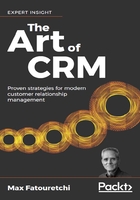
Case study — VeriPark
Before we go any further, I would like to take a real-life example from one of my partners I have been working with. The company is called VeriPark and it is a very successful CRM company that is operating across all the continents of the world. With its permission, we're going to explore its base (out-of-the-box) solution for a 360-degree client view and see how it has built a sophisticated role-based solution. We're going to share its experience, along with some of the best practices it committed to, and let you extract some of the knowledge that you'll be able to apply to your own journey.
After conducting business workshops with stakeholders and business analysts, VeriPark typically configures and integrates the base module for role-based solutions to each individual company's requirements and pain points. As we've highlighted in this chapter already, building a role-based, comprehensive, 360-degree client view is not, as it might look as a first impression, a walk in the park.
I remember working on a request for proposal (RFP) from another large multinational bank in the UK, where I was working on an operational company-wide CRM implementation. This bank decided to deploy a standard CRM solution and make in-house adaptions to it with its own in-house developers and business analysts in order to build the base system it wanted. This bank spent almost three years, and likely millions of pounds, in building the solution that was supposed to satisfy the requirements of the bank's business units. Yet, the experiment failed and in turn, the bank approached VeriPark for help, as it saw VeriPark's solution at an occasion with other vendors.
Building a single client view in private banking
In a nutshell, the objective of a private banking business is to provide financial services and investment products to high-net-worth individuals (HNWIs) who have a sizable asset, or even sometimes to institutional investors, depending on the business model of the company. Understandably, this business model is highly sensitive and personalized and therefore, a deep knowledge of the client is essential to the success of the business.
As I mentioned earlier, the SCV in the finance industry is the most comprehensive approach when compared to any other type of industry. Here, SCV is used for business orchestration, such as sales, the marketing processes, the sales pipeline, marketing campaigns, and customer services. In all of these cases, SCV is used as a measurement tool for managing the client life cycle and share of wallet.
CLM is the idea of using both processes and metrics to enable the company to better manage, measure, and analyze the performance of the business with the client over a longer period of time. The business supports the processes and data from all the business units related to the same client over the client's lifecycle. In the best-case scenario, this will be through all the stages of the lifecycle. The share of wallet is the analysis of the business a client has with your company compared to the business he or she has with your competitors. Through this, you can get a good picture for both cross-selling and upselling with the client.
The lifecycle of your customer starts with their acquisition, before you move on to profiling the customer, selling products, managing retention, loyalty, the growth of the business, both cross-selling and upselling, termination of the customer relationship, and customer win-back.
With the following chart, we can visualize the typical customer lifecycle:

Figure 2.4: Typical customer lifecycle
This process will be supported by the business processes a company uses to move its customer through the customer life stages. It is best managed within a CRM system, with related data in a single, efficient customer data repository. As you can see in the lifecycle chart featured in Figure 2.4, collecting, storing, managing, and viewing the data for a comprehensive 360-degree client view could become very complex if it's not designed in a very flexible way and managed by a comprehensive CRM system.